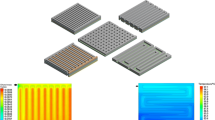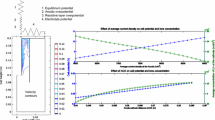Abstract
A method which treats the fuel cell anode as a chemical reactor is developed to predict fuel cell performance. The method is based on experimentally measured residence time distribution parameters and differential cell kinetic data. The apparatus and experimental technique used to obtain the gas-phase residence time distributions are described. Kinetic data obtained from differential cell tests of the electrodes are used to evaluate an empirical rate expression.
Axial dispersion model solutions for flow with volume change are obtained, based on the measured Peclet numbers and empirical rate expressions, and compared with experimental data from operating large high-temperature molten carbonate fuel cells. Agreement between the model and the experimentally determined data is very good, but only for low conversions of the fuel.
Similar content being viewed by others
Abbreviations
- A :
-
cross-sectional area, cm2
- C :
-
concentration of hydrogen. (g mole/cm3)
- c=C/C o :
-
dimensionless concentration of hydrogen
- D :
-
dispersion coefficient cm2/s
- d e :
-
equivalent diameter, cm
- F :
-
Faraday's constant
- I :
-
total current, A
- J :
-
current density, mA/cm2
- k :
-
reaction rate constant, appropriate units
- L :
-
length, cm
- M :
-
number of moles
- N =D/UL :
-
dispersion number
- n :
-
order of reaction
- n e :
-
number of electrons transferred
- −r:
-
rate of reaction based on volume of fluid, moles of reactant reacted/ cm3 s
- S e :
-
surface of electrode, cm2
- T :
-
absolute temperature, °K
- \(\bar t = \int\limits_0^\infty {\bar tE(t)dt} \) :
-
mean residence time, s
- U :
-
velocity component in Z direction, cm/s
- u = U/U 0 :
-
dimensionless velocity
- V a :
-
volume of system, cm3
- V :
-
operating voltage, V
- v :
-
volumetric flow rate, cm2/s
- \(x = \frac{{M_0 - M}}{{M_0 }}\) :
-
fractional conversion, degree of conversion of hydrogen
- y :
-
mole fraction of hydrogen
- Z:
-
space coordinate, cm
- z =Z/L :
-
fractional length
- \(\varepsilon = \frac{{V_{x = 1} - V_{x = 0} }}{{V_{x = 0} }}\) :
-
coefficient of expansion
- ρ m :
-
molar density of fuel, g mole/cm3
- η :
-
overvoltage, V
- \(\sigma _t^2 = \int\limits_0^\infty {(t - \bar t)^2 E(t)dt} \) :
-
dimensional variance, s2
- σ 2 :
-
dimensionless variance
- τ =Va/v 0 :
-
space time, s
References
B. S. Baker, Ed., ‘Hydrocarbon Fuel Cell Technology’, Academic Press, New York (1965).
E. Baur, W. D. Treadwell, and G. Trumpler,Z. Elektrochem.,27 (1921) 199.
C. Berger, ‘Handbook of Fuel Cell Technology’, Prentice Hall, Englewood Cliffs, N. J. (1968).
J. O'M. Bockris, and S. Srinivasan, ‘Fuel Cells: Their Electrochemistry’, McGraw-Hill, New York (1969).
M. W. Breiter, ‘Electrochemical Processes in Fuel Cells’, Springer-Verlag, New York (1969).
G. H. J. Broers, and J. A. A. Ketelaar, ‘Fuel Cells’, G. J. Young, ed., Reinhold, New York (1960).
G. H. J. Broers, and M. Schenke,ibid.‘.
H. H. Chambers and A. D. S. Tantram,ibid.‘.
P. V. Danckwerts,Chem. Eng. Sci.,2 (1953) 1.
O. K. Davytan,Bull. Acad. Sci. U.S.S.R. dasse Sci. Tech.,107 (1946) 125.
M. Duduković, MS Thesis, Illinois Institute of Technology, Chicago (1970).
L. T. Fan, and R. C. Bailie.,Chem. Eng. Sci.,13 (1960) 63,
D. Gidaspow,A.I.Ch. E. J.,13 (1967) 4.
Institute of Gas Technology, ‘JP-4 Fueled Molten Carbonate Fuel Cells,’ Contract No.DA-44-009-AMC-1465 (T) for U.S. Army Mobility Equipment Research and Development Center, Fort Belvoir, Virginia (January 1968).
O. Levenspiel, ‘Chemical Reaction Engineering’, John Wiley, New York (1962).
O. Levenspiel, and K. B. Bischoff, ‘Patterns of Flow in Chemical Process Vessels’, in ‘Advances in Chemical Engineering’, Vol. 4, Academic Press, New York (1963).
H. A. Liebhafsky atd E. J. Cairns, ‘Fuel Cells and Batteries’, John Wiley, New York (1968).
R. W. Lyczkowski, D. Gidaspow, and C. W. Solbrig,Chem. Eng. Progr. Symp. Ser.,63, No.77 (1967).
S. J. Oleksy, H. Weinstein, and A. B. Shaffer,J. Appl. Physiol.,26 (1969) 227.
R. K. Olson, MS Thesis, Illinois Institute of Technology, Chicago (1967).
A. D. S. Tantram, A. C. C. Tseung, and B. S. Harris, ‘Hydrocarbon Fuel Cell Technology’, B. S. Baker, ed., Academic Press, New York (1965).
Laan Van der,Chem. Eng. Sci.,7, (1958) 187.
J. F. Wehner, and R. H. W. Chelen,Chem. Eng. Sci.,6 (1965) 89.
K. R. Williams, ‘An Introduction to Fuel Cells’, Elsevier, Amsterdam (1966).
Author information
Authors and Affiliations
Rights and permissions
About this article
Cite this article
Duduković, M., Weinstein, H. & Ng, D.Y.C. Residence time distributions and reaction kinetics in a fuel cell anode. J Appl Electrochem 1, 219–230 (1971). https://doi.org/10.1007/BF00616945
Received:
Issue Date:
DOI: https://doi.org/10.1007/BF00616945




